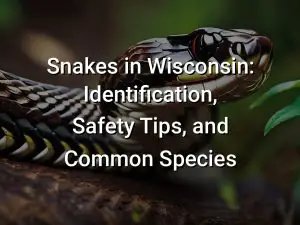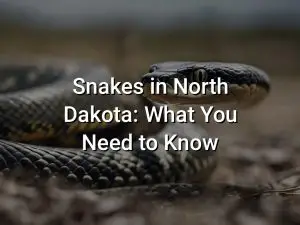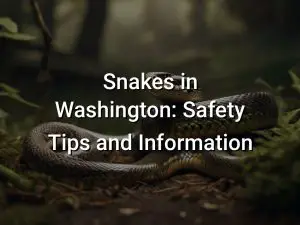Snakes in New Mexico: A Guide to Safety and Identification

New Mexico, with its diverse and stunning desert landscapes, is home to a wide variety of snakes. Whether you’re a resident or planning a visit, it’s important to be informed about these slithering creatures. In this guide, we’ll provide you with essential information about the types of snakes found in New Mexico, including venomous and non-venomous species, as well as tips on how to stay safe in snake-inhabited areas.
From the venomous rattlesnakes to the colorful coral snakes and the harmless garter snakes, New Mexico offers a plethora of snake species to discover. By understanding their characteristics, habitats, and identification techniques, you’ll be well-equipped to appreciate these fascinating reptiles while keeping yourself and others out of harm’s way. So let’s dive into the world of snakes in New Mexico and learn how to coexist with them safely.
Quick Links
Types of Snakes in New Mexico
New Mexico is home to a variety of snake species, both venomous and non-venomous. It’s essential to be able to identify these snakes to ensure your safety and the preservation of these reptiles. Here are some common types of snakes you may encounter in New Mexico:
- Rattlesnakes
- Coral Snakes
- Garter Snakes
- Bullsnakes
- Coachwhip Snakes
- Common Snakes
Each of these snakes has distinct characteristics, behaviors, and habitats. Understanding their differences can help you make informed decisions when encountering them in the wild.
Venomous Snakes in New Mexico
New Mexico is home to a variety of snake species, some of which are venomous. It’s important to be able to identify these venomous snakes to ensure your safety. Here are some of the venomous snakes you may encounter in New Mexico:
- Rattlesnakes: Rattlesnakes are the most well-known venomous snakes in New Mexico. They have a distinct rattle at the end of their tails, which they use as a warning sign when they feel threatened. There are several species of rattlesnakes in New Mexico, including the Western Diamondback, the Mojave Rattlesnake, and the Prairie Rattlesnake.
- Coral Snakes: Coral snakes are less common but still venomous. They have bright red, yellow, and black bands along their bodies. It’s important to note that coral snakes have a different venom delivery system than rattlesnakes, so it’s crucial to exercise caution if you come across one.
If you encounter a venomous snake in New Mexico, it’s important to remember the following safety tips:
- Always give snakes their space and do not attempt to handle or provoke them.
- Wear long pants and sturdy boots when hiking in snake-prone areas.
- Watch where you step and be cautious when reaching into hidden or dark areas where snakes may be hiding.
- If you are bitten by a venomous snake, seek medical attention immediately. Do not attempt to suck out the venom or use a tourniquet.
By staying informed and taking precautionary measures, you can safely coexist with snakes in New Mexico.
Non-Venomous Snakes in New Mexico
New Mexico is home to a variety of non-venomous snakes, which play an important role in the state’s ecosystem. These snakes are generally harmless to humans and can even be beneficial, as they help control rodent populations and maintain a balanced ecosystem. Here are some of the non-venomous snakes you may encounter in New Mexico:
- Garter Snakes: Garter snakes are one of the most common snakes found in New Mexico. They are typically small to medium-sized with distinctive striped patterns running along their bodies. Garter snakes are harmless and often found near water sources such as ponds, rivers, and streams.
- Bullsnakes: Bullsnakes are large, powerful snakes that can grow up to six feet in length. They are often mistaken for rattlesnakes due to their similar appearance and habit of vibrating their tails when threatened. However, bullsnakes are non-venomous and primarily feed on rodents.
- Coachwhip Snakes: Coachwhip snakes are slender, fast-moving snakes characterized by their long tails and reddish-brown coloration. They are excellent climbers and can reach speeds of up to 10 miles per hour on the ground. Coachwhip snakes are non-venomous and primarily feed on small animals.
- Common Snakes: New Mexico is also home to various species of common snakes, such as ribbon snakes, water snakes, and rat snakes. These snakes are non-venomous and typically harmless to humans, preferring to prey on small animals and insects.
It’s important to remember that even though these snakes are non-venomous, it’s always best to observe them from a safe distance and avoid disturbing or provoking them. If you encounter a snake in the wild, give it plenty of space and allow it to retreat to its natural habitat.
Rattlesnakes in New Mexico
Rattlesnakes are a common sight in New Mexico and are known for their distinctive rattling sound. There are several species of rattlesnakes found in the state, including the Western Diamondback, the Mojave, and the Prairie Rattlesnake.
Rattlesnakes are venomous snakes and should be approached with caution. They have long fangs that can inject venom into their prey or a potential threat. If you encounter a rattlesnake in the wild, it is best to keep your distance and avoid provoking or harassing the snake.
Rattlesnakes are most active during warmer months, usually from late spring to early fall. They can be found in a variety of habitats, including deserts, grasslands, and rocky areas. They are often found near sources of water, as they need to stay hydrated.
When hiking or spending time outdoors in rattlesnake territory, it is important to be aware of your surroundings and take precautions to avoid snake bites. Here are some safety tips to keep in mind:
- Stay on designated trails and avoid tall grass or brush where snakes may be hiding.
- Watch where you step and use a walking stick to probe the area in front of you.
- Wear sturdy, closed-toe shoes or boots to protect your feet.
- Be cautious when reaching into crevices or under rocks, as snakes may be hiding there.
- If you encounter a rattlesnake, give it plenty of space and do not try to handle or kill it.
- If you are bitten by a rattlesnake, seek immediate medical attention.
Being informed and prepared can help you stay safe while enjoying the outdoors in New Mexico. Remember, snakes play an important role in the ecosystem, so it is best to observe them from a safe distance and respect their territory.
Coral Snakes in New Mexico
Coral snakes are a type of venomous snake that can be found in New Mexico. They are known for their distinctive bands of red, yellow, and black along their bodies. It’s important to note that coral snakes are not aggressive and will only bite if they feel threatened or provoked.
If you encounter a coral snake in New Mexico, it’s best to keep your distance and avoid any unnecessary interaction. Coral snake bites can be dangerous, and it’s crucial to seek medical attention immediately if you are bitten.
Here are some key characteristics and safety tips to help you identify and stay safe around coral snakes in New Mexico:
- Coloration: Coral snakes in New Mexico have bright bands of red, yellow, and black along their bodies. It’s important to remember the rhyme “Red touches yellow, kill a fellow” to distinguish them from non-venomous snakes with similar coloration.
- Size: Coral snakes in New Mexico are typically small, with adults averaging around 2 to 3 feet in length.
- Habitat: Coral snakes prefer sandy or rocky habitats, such as deserts, grasslands, and scrublands. They can also be found near streams or other sources of water.
- Behavior: Coral snakes in New Mexico are shy and reclusive. They spend most of their time hidden under rocks, logs, or in burrows.
- Prevention: To prevent encounters with coral snakes, it’s important to stay on designated trails and avoid reaching into or under potential hiding spots, such as rock crevices or piles of debris.
- First Aid: If bitten by a coral snake, it is crucial to seek medical attention immediately. Keep the affected limb immobilized and below heart level, and try to remember the snake’s appearance for identification purposes.
By being aware of the characteristics and safety tips associated with coral snakes in New Mexico, you can better protect yourself and appreciate these fascinating creatures from a safe distance.
Garter Snakes in New Mexico
Garter snakes are a common sight in New Mexico and are generally harmless to humans. These snakes are known for their vibrant colors and distinct markings, which can vary depending on the specific species.
There are several species of garter snakes found in New Mexico, including the common garter snake (Thamnophis sirtalis) and the terrestrial garter snake (Thamnophis elegans). They can be found in a variety of habitats, including grasslands, woodlands, and even urban areas.
Garter snakes are non-venomous and rely on their speed and agility to catch prey, which primarily consists of small amphibians, fish, and invertebrates. They are also known for their ability to release a foul-smelling musk when threatened as a defense mechanism.
These snakes play an essential role in controlling pest populations and are generally beneficial for the ecosystem. However, if you encounter a garter snake, it’s important to remember that they are wild animals and should be observed from a safe distance. Avoid handling them unless you are experienced in dealing with snakes.
If you have a garter snake in your yard or property and would prefer it to be relocated, contact local wildlife authorities or snake removal professionals who can assist you in safely removing and relocating the snake.
It’s also important to keep in mind that while garter snakes are generally harmless, it’s always a good idea to familiarize yourself with the different snake species in New Mexico and understand basic snake bite prevention and safety tips to ensure your own well-being.
Bullsnakes in New Mexico
Bullsnakes, also known as gopher snakes, are large non-venomous snakes native to New Mexico. They are often mistaken for rattlesnakes due to their similar appearance, but they are completely harmless to humans.
These snakes can grow up to 6 feet in length and have a distinct pattern of brown or yellowish scales with dark blotches. They have a triangular-shaped head and round pupils. Bullsnakes are powerful constrictors and feed on small mammals, birds, and reptiles.
Bullsnakes play an important role in controlling rodent populations, making them beneficial to have in the ecosystem. They are usually docile and non-aggressive, but they may hiss and mimic the sound of a rattlesnake when threatened as a defense mechanism.
If you encounter a bullsnake in New Mexico, it is best to observe it from a safe distance and not attempt to handle or harm it. Remember, they are harmless and contribute to the natural balance of the ecosystem.
Coachwhip Snakes in New Mexico
Coachwhip snakes are non-venomous snakes that can be found in New Mexico. They are known for their long and slender bodies, often reaching lengths of up to 8 feet. These snakes have a distinctive appearance, with their reddish-brown or tan coloration and scales that have a glossy sheen.
Coachwhip snakes are fast and agile, making them excellent hunters. They primarily feed on small mammals, birds, lizards, and other snakes. Their diet and hunting behavior contribute to their name, as they are known for swiftly moving through vegetation and whipping their bodies back and forth to capture prey.
When it comes to their behavior, coachwhip snakes are generally shy and non-aggressive towards humans. They are typically more active during the day and will try to escape if they feel threatened. However, if cornered or provoked, they may bite or strike defensively, although their bites are not venomous.
If you encounter a coachwhip snake in New Mexico, it is best to observe it from a safe distance and avoid any sudden movements or attempts to handle it. It is important to remember that these snakes play a beneficial role in the ecosystem by helping control rodent populations and should be respected and left undisturbed in their natural habitat.
Common Snakes in New Mexico
In addition to the venomous and non-venomous snakes found in New Mexico, there are several species of snakes that are commonly encountered in the state. These snakes are generally harmless to humans and play important roles in the ecosystem.
Here are some of the common snakes you may come across in New Mexico:
- Garter Snakes: Garter snakes are small to medium-sized snakes with distinct stripes running from their head to tail. They are non-venomous and often found near water sources.
- Bullsnakes: Bullsnakes are large snakes that can reach lengths of up to six feet. They are non-venomous and are known for their defensive behavior, such as hissing and rattling their tail.
- Coachwhip Snakes: Coachwhip snakes are slender and fast-moving snakes with a whip-like tail. They are non-venomous and often found in open grasslands and desert habitats.
These common snakes are generally not aggressive towards humans and will typically try to avoid confrontation. If you encounter one of these snakes, it is best to keep your distance and allow the snake to go on its way.
Remember, it is important to always treat snakes with caution and respect, even if they are non-venomous. If you are unsure about the identification or behavior of a snake, it is best to observe it from a safe distance or contact a local wildlife organization for assistance.
Snake Bite Prevention and Safety Tips
When spending time in areas where snakes are known to inhabit, it’s important to take precautions to prevent snake bites. Here are some safety tips to keep in mind:
- Stay on designated trails and avoid walking through tall grass and underbrush, where snakes may be hiding.
- Wear long pants and sturdy boots to provide some protection against snake bites.
- Watch where you step and use a walking stick to probe the area in front of you, especially in areas with limited visibility.
- Be aware of your surroundings and listen for any warning signs, such as the sound of a rattlesnake’s rattle.
- Avoid approaching or handling snakes, even if they appear to be non-venomous. Snakes may strike if they feel threatened or cornered.
- If you encounter a snake, give it a wide berth and slowly back away. Do not make sudden movements or try to provoke the snake.
- Keep your pets on a leash and under control when outdoors to prevent them from encountering snakes.
- Teach children to respect snakes and the importance of not approaching or touching them.
- If you are camping or picnicking, keep your food and trash properly stored to avoid attracting snakes.
- In the event of a snake bite, seek medical attention immediately. Do not try to handle the situation on your own.
By following these safety tips and staying vigilant, you can reduce the risk of snake bites and enjoy your time outdoors in New Mexico.
Conclusion
Snakes in New Mexico can be both fascinating and potentially dangerous creatures. It’s important to be able to recognize the different types of snakes in the region, particularly the venomous ones, in order to stay safe while enjoying the great outdoors.
By familiarizing yourself with the characteristics and habitats of these snakes, following snake bite prevention and safety tips, and being aware of your surroundings, you can minimize the risk of encountering a snake and ensure a safe and enjoyable experience in the beautiful state of New Mexico.






